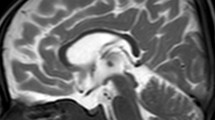Abstract
Recent reports attribute neurological and cerebral disorders to the accumulation of manganese (Mn) in the brain in patients receiving home parenteral nutrition (HPN). It is desirable to control the amount of Mn delivered to these patients, but a suitable method for monitoring an individual's Mn status and assessing Mn accumulation remains debatable. The aim of this study was to evaluate whether whole-blood manganese levels (WB-Mn) correlate with the accumulation of Mn in the brains of children who receive long-term HPN, using magnetic resonance imaging (MRI) of the brain. Six patients who had received HPN (duration of HPN, 18–137 months) were included in this study. The daily parenteral doses of Mn were calculated while on HPN. WB-Mn was measured and T1-weighted MRI of the brain was obtained for each patient with a 1.5-T MR imager. Twelve months after the withdrawal of Mn from HPN, measurements of WB-Mn and brain MRI were repeated in all patients except for one who was lost after initial examination. The same examinations were performed on an additional patient who had been successfully weaned off a 179 month course of HPN 20 months prior to the initial examination. The parenteral dose of Mn while receiving HPN ranged from 15.7 to 91.5 μg/kg/day. Initially, MRI showed hyperintensity in the globus pallidus in all patients and in the anterior pituitary in one patient. WB-Mn was elevated in four patients, but was in the normal range in the remaining three. Following subsequent measurements 12 months later, WB-Mn was normal in all patients and MRI hyperintensity remained in the globus pallidus in one patient. One patient was lost after the initial examinations. WB-Mn does not necessarily correlate with the accumulation of Mn in the brain. Periodic MRI should be performed in patients receiving long-term NPN to monitor for excessive Mn accumulation in the brain.


Similar content being viewed by others
References
American Medical Association, Department of Foods and Nutrition (1979) Guidelines for essential trace element preparations for parenteral use. JAMA 241:2051–2054
A.S.P.N. Board of Directors (1998) Safe practices for parenteral nutrition formulations. JPEN J Parenter Enteral Nutr 22:49–66
Bertinet DB, Tinivella M (2000) Brain manganese deposition and blood levels in patients undergoing home parenteral nutrition. JPEN J Parenter Enteral Nutr 24:223–227
Davis CD, Greger JL (1992) Longitudinal changes in women of manganese superoxide dismutase and other indices of manganese and iron status with diet. Am J Clin Nutr 55:747–752
Ejima A, Imamura T (1992) Manganese intoxication during TPN. Lancet 339:426
Fell JME, Reynolds AP (1996) Manganese toxicity in children receiving long-term parenteral nutrition. Lancet 347:1218–1221
Fitzgerald K, Mikalunas V (1999) Hypermanganesemia receiving total parenteral nutrition. JPEN J Parenter Enteral Nutr 23:333–336
Greene HL, Hambidge KM (1998) Guidelines for the use of vitamins, trace elements, calcium, magnesium, and phosphorus in infants and children receiving TPN: report of the subcommittee on clinical Pediatric Parenteral Nutrient requirements from the Committee on Clinical Practice Issues of The American Society for Clinical Nutrition. Am J Clin Nutr 48:1324–1342
Keen CL, Clegg MS (1983) Whole blood manganese as an indicator of blood manganese. N Engl J Med 308:1230
Kouhichirou O, Ito J (1998) Reversible hyperintensity of the anterior pituitary gland on T1-weighted MR images in patients receiving temporary parenteral nutirition. AJNR Am J Neuroradiol 19:1287–1289
Malecki EA, Lo H-C (1995) Tissue manganese concentrations and antioxidant enzyme activities in rat given total parenteral nutrition with and without supplemented manganese. JPEN J Parenter Enteral Nutr 19:222–226
Masuda A, Mimura M (1994) Changes in manganese content of mononuclear blood cells in patients receiving total parenteral nutrition. Clin Chem 40:829–832
Masumoto K, Suita S (2001) Manganese intoxication during intermittent parenteral nutrition: report of two cases. JPEN J Parenter Enteral Nutr 25:95–99
Mirowitz SA, Westrich TJ (1991) Hyperintense basal ganglia on T1-weighted MR imagings in patients receiving long term parenteral nutrition. Radiology 181:117–120
Misselwitz B, Muhler A (1995) A toxicologic risk for using manganese complexes? A literature survey of existing data through several medical specialities. Invest Radiol 30:611–620
Ono J, Harada K (1995) Manganese deposition in the brain during long-term total parenteral nutrition. JPEN J Parenter Enteral Nutr 19:310–312
Quaghebeur G, Taylor WJ (1996) MRI in children receiving total parenteral nutirition. Neuroradiology 38:680–683
Reimund JM, Dietemann JL (2000) Factors associated with hypermanganesemia in patients receiving home parenteral nutrition. Clin Nutr 19:343–348
Reynolds AP, Kiely E (1994) Manganese deposition in long term parenteral nutrition. Arch Dis Child 71:527–528
Reynolds N, Blumsohn A (1998) Manganese requirement and toxicity in patients on home parenteral nutrition. Clin Nutr 17:227–230
Takagi Y, Okada A (2001) On-off study of manganese administration to adult patients undergoing home parenteral nutrition: new indicates of in vivo manganese level. JPEN J Parenter Enteral Nutr 25:87–92
Wardle CA, Forbes A(1999) Hypermanganesemia in long-term intravenous nutrition and chronic liver disease. JPEN J Parenter Enteral Nutr 23:350–355
Author information
Authors and Affiliations
Corresponding author
Rights and permissions
About this article
Cite this article
Iinuma, Y., Kubota, M., Uchiyama, M. et al. Whole-blood manganese levels and brain manganese accumulation in children receiving long-term home parenteral nutrition. Ped Surgery Int 19, 268–272 (2003). https://doi.org/10.1007/s00383-002-0929-6
Accepted:
Published:
Issue Date:
DOI: https://doi.org/10.1007/s00383-002-0929-6




